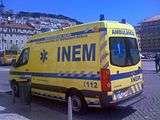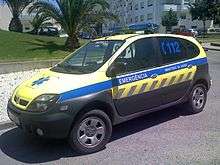Emergency medical services in Portugal

Emergency medical services in Portugal are organized in three separate systems, one each covering Continental Portugal, the Azores and Madeira. The largest system is the SIEM, which covers the territory of Continental Portugal.
The modern Portuguese emergency medical services were created in 1964, initially being provided only in the major cities (Lisbon and then Porto, Coimbra, Aveiro, Setúbal and Faro) by PSP Police ambulances and staff. These services were activated through a telephone call to the national emergency number 115. In 1971, the National Ambulance Service (SNA) was created, theis being latter absorbed by the INEM when this was created 10 years later. The SIEM was created in 1980. In the 1990s, the national emergency number 115 was replaced by the European common emergency number 112.
The SIEM
The Integrated System of Medical Emergency (Portuguese: Sistema Integrado de Emergência Médica) or SIEM is centrally managed by the National Institute of Medical Emergency (INEM), which is part of the Portuguese Ministry of Health.[1] It covers Continental Portugal and operates like other SAMU/IEMS networks of Europe or Brazil.
In Portugal, the free of charge emergency telephone number for emergency medical service is the 112. When someone calls 1-1-2, the call is directed to a PSP Police dispatch center. Accordingly, to the type of emergency, the PSP dispatch center redirects the call to the appropriate emergency services. In Continental Portugal, medical emergency calls are directed to one of the INEM's urgent patients guidance centers (Portuguese: centro de orientação de doentes urgentes) or CODU. There are four regional CODU (Lisbon, Oporto, Coimbra and Faro). Additionally, there is the CODU-Mar that responds to medical emergencies at the sea.
Besides the CODU, the SIEM also includes the INEM's Anti-Poison Information Center (CIAV) - that provides 24/7 toxicological medical information at national level (including in Azores and Madeira) - and the Pediatric Inter-Hospital Transport (TIP) subsystem - providing emergency transportation of high risk newborns to specialized hospital units.
Under the coordination of the CODU, a number of specialized mobile resources operate, including ambulances, fly cars, air ambulances and motorcycle ambulances. The ambulances are either directly operated by the INEM from its regional delegations or are operated from the medical emergency and reserve posts installed in the local fire departments or local delegations of the Portuguese Red Cross.
Mobile Resources
The SIEM includes standard medical emergency mobile resources, some of them directly operated by the INEM, while others are operated by fire departments, the Portuguese Red Cross or other entities. The following resources exist:
- Ambulância de emergência médica (AEM) - basic life support ambulance, crewed by two emergency medical technicians. All AEM are owned by the INEM, but the operation of some of them is delegated in other entities like the local fire departments. AEM are complemented by fire departments owned ABSC (fire rescue ambulances);[2]
- Ambulância de suporte imediato de vida (SIV) - immediate life support ambulance, similar to an AEM, but including an emergency medical nurse in their crew, instead of the second emergency medical technician;[3]
- Viatura médica de emergência e reanimação (VMER) - resuscitation and emergency medical vehicle (fly car), crewed by an emergency medical physician and a nurse;[4]
- Ambulância de suporte avançado de vida pediátrico - pediatric advanced life support ambulance, crewed by physician, a nurse and an emergency medical technician;
- Helicóptero de emergência médica - medical emergency helicopter (air ambulance), crewed by two pilots, a physician and a nurse;[5]
- Motociclo de emergência médica - medical emergency motorcycle (motorcycle ambulance), crewed by a single medical emergency technician;[6]
- Veículo de intervenção em catástrofe - disaster intervention vehicle, carrying advanced life support equipment and being able to install a small field hospital and a mobile communications center.[7]
- Portuguese EMS mobile ressources
-

INEM's AEM ambulance
-

INEM's VMER
-
_AN0666534.jpg)
INEM's medical emergency helicopter
-

Paço d'Arcos Voluntary Fire Department's ambulance
Services in the Portuguese Atlantic islands
As part of their developed power, the Portuguese autonomous regions of Azores and Madeira have their own separate emergency medical services, under the control of the respective regional secretaries of Health. These services are smaller but share many common features with the SIEM.
In Madeira, the emergency medical services are coordinated by the Regional Medical Emergency Service (SEMER), mirroring in the region the role of the INEM in Continental Portugal. The SEMER includes the Rapid Intervention Medical Team (EMIR) prepared to provide medical rescue in any part of the region, including rescue in maritime and air environment if needed.
In the Azores, the emergency medical services are centrally managed by the Regional Civil Protection and Fire Service.
Unlike Continental Portugal, where the air ambulance service is mainly provided directly by the INEM through its own helicopters, in the Atlantic islands, the Portuguese Air Force is in charge of the emergency patient evacuations between islands and from ships, using rotary and/or fixed wing aircraft (usually EADS CASA C-295 aircraft operated by the 502 Squadron and EH-101 helicopters operated by the 751 Squadron), in combination if needed.
See also
References
- ↑ "Decreto-Lei n.o 220/2007 de 29 de Maio. Diário da República, 1.a série—N.o 103—29 de Maio de 2007" (PDF) (in Portuguese). 29 May 2007. Retrieved 2010-12-20.
- ↑ "Ambulâncias SBV do INEM". Retrieved 2010-12-20.
- ↑ "Ambulâncias SIV do INEM". Retrieved 2010-12-20.
- ↑ "VMER do INEM". Retrieved 2010-12-20.
- ↑ "Helicóptero do INEM". Retrieved 2010-12-20.
- ↑ "Motociclo do INEM". Retrieved 2015-03-08.
- ↑ "VIC INEM". Retrieved 2015-03-08.
External links
- INEM
- [Serviço de Atençao Medica Urgente]